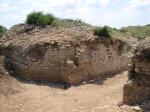Summary (English)
In the Ivoševci village, at the position of Karlovac, the systematic archaeological excavation and conservation work on the amphitheatre situated in the Roman military camp at the site of Burnum continued. Archaeological excavations began in the fall of 2003 and were continuously carried on during 2004 and 2005. During 2005, the southern and northern entrances of the amphitheatre were excavated. Archaeological excavations of the Burnum amphitheatre started at its southern entrance, which after the excavation was thoroughly documented and processed. It is 4.40 m wide and 12.38 m long. The passage has the shape of a corridor and was vaulted. On the façade above the entrance, there was originally a monumental inscription of Emperor Vespasian, found during the excavation of the lower layer of construction rubble. The inscription is preserved but broken into two parts.
IMP . CAESAR . VESPASIANVS . AVG . PONT . MAX
TRIB . POT . VIII . IMP . XVIII . P(ater) . P(atriae)
At the mouth of the passage towards the arena, on the right, a regularly shaped cut in the bedrock appeared, which probably served as a staircase leading to the slope with the auditorium. Unfortunately, only minor remains of the stairs were preserved. Between the left and right walls of the so-called funnel entrance, a soil deposit was established and archaeologically excavated. Over a hundred artefacts were found – from coins to parts of military equipment, weapons, items for everyday use, fragments of glass and ceramic vessels, etc.
Excavation of the northern entrance of the amphitheatre began in 2004. Unlike the southern and eastern passages, this passage was excavated from the direction of the arena because by then most of the inner ring had already been excavated and it was quite clear that there must have been an entrance. The excavation was dictated by the side walls of the passage. At the outer end of the passage, on the left side of the entrance (seen from the inside), there was also a funnel-shaped expansion. On the right, the wall follows the outer shape of the amphitheatre and does not form a funnel-shaped expansion. This entrance is better preserved than the southern one, but their constructions are very similar. It is 4.33 m wide and 18.75 m long. Although the vault collapsed, there is no doubt that it was vaulted. At the northern entrance, remains of the outer ring of the amphitheatre have not yet been identified as the dig has not yet expanded in the relevant directions. During this campaign, only a few artefacts were found, primarily iron nails and pegs, fragments of ceramic and glass vessels. No coins were found. However, the high embankment layer in front of the northern entrance is likely to offer finds that will contribute to the precise dating of that part of the amphitheatre (J. Zaninović 2006, Hrvatski arheološki godišnjak 2/2005, 326–327).
- Joško Zaninović
Director
- Joško Zaninović
Team
Research Body
- Gradski muzej Drniš
- Odjel za arheologiju Sveučilišta u Zadru






![Download [PDF]](/excavation/skins/fasti/images/results/download_sml.png)

